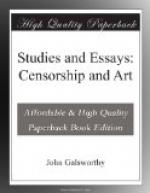And so—I thought it must always be; for Time is essential to the proper placing and estimate of all Art. And is it not this feeling, that contemporary judgments are apt to turn out a little ludicrous, which has converted much criticism of late from judgment pronounced into impression recorded—recreative statement—a kind, in fact, of expression of the critic’s self, elicited through contemplation of a book, a play, a symphony, a picture? For this kind of criticism there has even recently been claimed an actual identity with creation. Esthetic judgment and creative power identical! That is a hard saying. For, however sympathetic one may feel toward this new criticism, however one may recognise that the recording of impression has a wider, more elastic, and more lasting value than the delivery of arbitrary judgment based on rigid laws of taste; however one may admit that it approaches the creative gift in so far as it demands the qualities of receptivity and reproduction—is there not still lacking to this “new” critic something of that thirsting spirit of discovery, which precedes the creation—hitherto so-called—of anything? Criticism, taste, aesthetic judgment, by the very nature of their task, wait till life has been focussed by the artists before they attempt to reproduce the image which that imprisoned fragment of life makes on the mirror of their minds. But a thing created springs from a germ unconsciously implanted by the direct impact of unfettered life on the whole range, of the creator’s temperament; and round the germ thus engendered, the creative artist—ever penetrating, discovering, selecting—goes on building cell on cell, gathered from a million little fresh impacts and visions. And to say that this is also exactly what the recreative critic does, is to say that the interpretative musician is creator in the same sense as is the composer of the music that he interprets. If, indeed, these processes be the same in kind, they are in degree so far apart that one would think the word creative unfortunately used of both....




